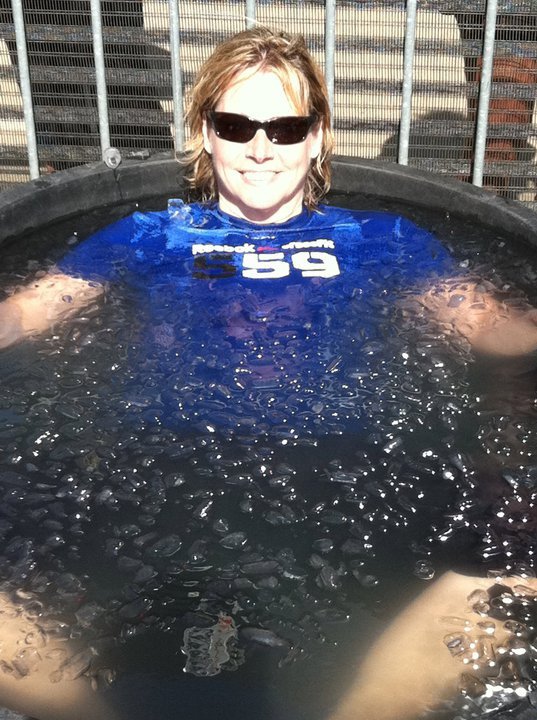January 1st is unofficially recognized as Polar Bear Plunge Day. It’s the day when thousands of brave souls worldwide strip down to their bathing suits despite winter temperatures and throw themselves (or tiptoe) into icy cold water. These people seem nutty, but perhaps they are onto something?
Applying ice is one of the most widely accepted methods for reducing pain and swelling in an injured area. But what about cold therapy for post-race or workout recovery? Professional athletes have long used ice baths, and most training rooms are equipped with tubs for cold water immersion, but the trend has more recently spread to recreational sports as well. With this growth in popularity, it’s important to explore how ice therapy works for both specific injuries and the entire body, and whether it’s right for you.
Why dunk yourself in cold water after an intense workout?
Also known as cold water immersion, ice baths are a form of cryotherapy in which an athlete sits in chilled water after significant physical exertion for a specific period. Ice bath immersion is believed to accomplish the following:
- Facilitate recovery
- Decrease soreness
- Reduce the risk of injury by speeding recovery and allowing you to be better prepared for the next workout, which can be of higher quality
Many studies have investigated the benefits of ice baths after athletic performance, and although the findings are inconclusive, research has confirmed that it can bring about the benefits listed above. In addition, many athletes swear by ice bath immersion and have experienced significant gains in recovery and performance after using them. Athletic trainers can attest to this as well.
What does icing do to the body?
After a very intense or long workout, or after a race—which is essentially the most intense workout—the body has just experienced a state of elevated body temperature, high cardiovascular demand, and muscular stress. Inflammation from muscular stress triggers an immune response, which causes blood vessels to dilate and sends an influx of immune cells to the areas of stress. This process is helpful because it repairs the injured tissue, but too much of a good thing can lead to some negative repercussions. In this case, the result of all this inflammation is swelling and pain.
For an injury to a specific area of the body, applying an ice pack will cause blood vessels in the region to constrict (become smaller), which reduces swelling, and less swelling results in less pain. Cold also slows down the speed at which nerves send messages, which is another way in which pain is reduced.
Immersing the body in cold water is a more efficient way of cooling down multiple groups of muscles at the same time. Just like an ice pack, it reduces swelling and muscle damage from exercise by constricting blood vessels and decreasing metabolic activity. It also reduces strain on the cardiovascular system and brings down hyperthermia (elevated body temperature), which can reduce fatigue. For both local icing and ice bath immersion, another beneficial part of the process comes after the cold stimulus has been removed. During this warming period, there is a return of fresh blood to the body, which floods the cells with nutrients and oxygen, and helps to flush out the waste products of tissue breakdown.
How to ice
If you’re thinking about using ice after an injury or workout, here are some tips to keep in mind:
- Local injury
- Apply a cold pack (or a bag of peas works!) to the injured area, immediately after the injury
- Be sure to place a thin cloth between your and the icepack (a pillowcase works well) to prevent frostbite
- Keep the pack on for 10-15 minutes
- This can be performed a few times a day as pain and swelling persists
- Ice bath
- Most studies suggest immersing one’s body up to the hips at a temperature of 50-60° for 10-15 minutes
- Make sure there is someone nearby for your safety and in case you have trouble lifting yourself out of the bath due to numbness or fatigue
- Be sure to fully warm up about 30-60 minutes later with a warm shower or hot drink since the cold can make muscles tense and stiff
One important reminder is that you should never ice a body part or take an ice bath before running, racing, or any other workouts. The body needs to be warm before these activities, and ice can also decrease strength and delay the body’s reaction time.
Ice baths should be reserved only for after the hardest training sessions or races, or if you will be performing again soon afterwards (like back-to-back races). It is most beneficial for short-term recovery between events or hard workouts, and research suggests that it can hinder long-term adaptations. This is why ice baths should be avoided during a building phase of training. Research has also shown that icing after strength training can actually slow down the growth of new muscle, so if the goal of your workout is to build strength, it may not be the best choice for you.
Remember that after a tough workout or race, it’s also important to rest, rehydrate, and replenish your body with healthy food to help you recover as quickly as possible.
If you’re interested in learning more about cold therapy in any form, or if you’re dealing with some lingering pain that hasn’t improved despite the use of ice, we can help. Contact Dynamic Sports Physical Therapy in New York City at 212-317-8303 to schedule an appointment today, or click here for more information on ice baths.

